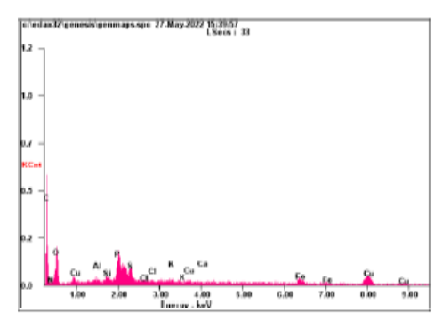


Indian Journal of Science and Technology
Year: 2023, Volume: 16, Issue: 24, Pages: 1802-1809
Original Article
P Jenavio Maria Amirtham1, R Shenbhagaraman2, R Siva1*
1Department of Plant Biology and Plant Biotechnology, Shrimathi Devkunvar Nanalal Bhatt Vaishnav College for Women, Chrompet, Chennai, India
2Centre for Materials Engineering and Regenerative Medicine, Bharath Institute of Higher Education and Research, Selaiyur, Chennai, India
*Corresponding Author
Email: [email protected]
Received Date:04 February 2023, Accepted Date:31 May 2023, Published Date:24 June 2023
Objectives: To investigate the antibacterial activity and photo-catalytic efficacy of CuNPs synthesized from Lentinus squarrosulus used for the degradation of commercial textile dyes. Methods: The Copper nanoparticles (CuNPs) were biosynthesized using L. squarrosulus, a new fungal isolate from the dead trunk of N. odorum. The production of copper nanoparticles using mycoextract was simple and environmentally friendly, yielding stable copper nanoparticles in a variety of shapes. Fourier transform infrared spectroscopy (FTIR), Scanning electron microscopy (SEM), and EDAX analysis have all been used to establish that CuNPs were successfully formed. Findings: The research findings of the present study show that absorption spectra around 300 to 350 nm in UV-vis spectra followed by the presence of FT-IR peaks at 3680cm1 and 3856.7cm1 of proteins, carbohydrates, flavonoids, and tannins confirmed the myco-synthesis of copper nanoparticles using L. squarrosulus. Additionally, scanning electron microscopy examination of their external morphology reveals the existence of CuNPs with an average particle size of about 200 nm each, which are the primary spherical nanoparticles. Energy-dispersive x-ray (EDX) analysis was performed to further investigate the configuration of copper nanoparticles and it was found that, pure copper (03.51 percent) was present in CuNPs. The produced CuNPs were assessed for their antimicrobial activity and the results show that they were highly effective against Enterobacter aerogenes MTCC 2823 and Streptococcus mutans MTCC 497, while Escherichia coli MTCC 739 and Enterococcus faecalis MTCC 439 showed moderate antibacterial activity. Further, the photocatalytic dye degradation potentials of myco-synthesized CuNPs showed higher degradation efficiency in fast green dye, moderate degradation rate in Congo red dye and a very low degradation rate in the brilliant blue dye. Novelty : Preparation of mycogenic copper nanoparticlesfrom L. squarrosulus and their photocatalytic degradation of organic dyes are the novel part in this study as there is no remarkable study in specific CuNPs.
Keywords: Lentinus Squarrosulus; Antibacterial; Green Synthesis; Photocatalytic; Dye Degradation; Copper Nanoparticles
© 2023 Amirtham et al. This is an open-access article distributed under the terms of the Creative Commons Attribution License, which permits unrestricted use, distribution, and reproduction in any medium, provided the original author and source are credited. Published By Indian Society for Education and Environment (iSee)
Subscribe now for latest articles and news.